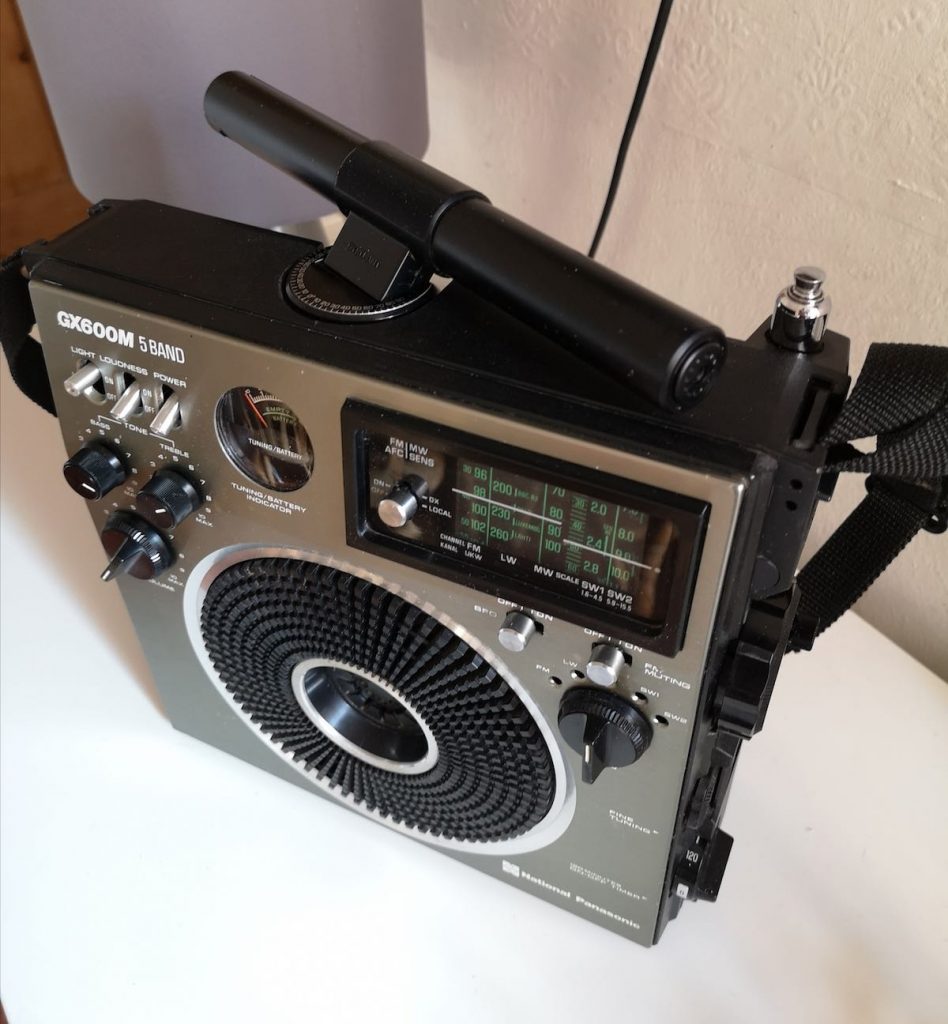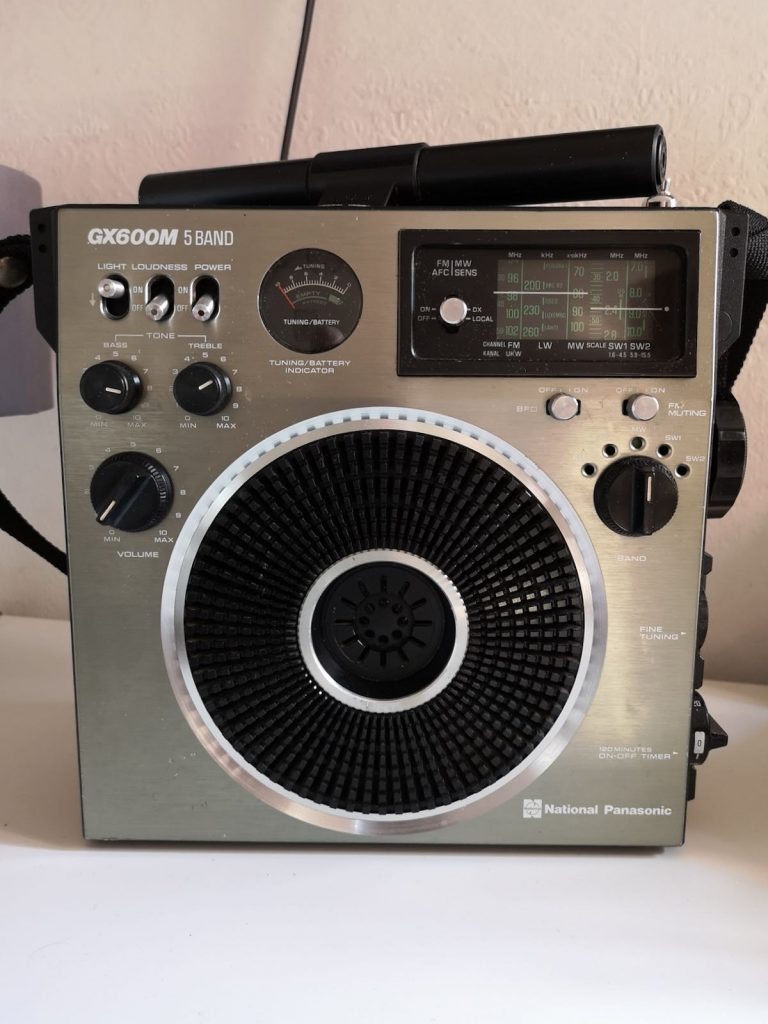Many thanks to SWLing Post contributor, Mark Lane, who writes:
Hi Thomas,
I have been reading the SWLing Post for a few years now but hadn’t contacted yourself since I announced my re kindled interest in SW and radio in general when I purchased a Sony ICF2001D a couple of years ago.
Well since then I had also bought a couple of modern travel radios but was hankering after something more retro.
I recently was lucky enough to receive a small bonus from work and thought it was an excellent opportunity to have another hunt for the European version of the Panasonic RF2200.
I had heard so much about this radio and really wanted a good analogue set. However, trying to find one in good condition in the UK was proving difficult to say the least.
Whilst hunting, I did find a radio that peaked my interest. I had not come across it before but was intrigued, initially by the looks and then read up on it a little. The Panasonic RF1150. After a few days of debating I took the plunge and bought one.
I don’t know if any other readers of the Post have or have had this radio but I must say I am very impressed with the MW and deep sound on this radio from the large speaker.
I am no expert, still learning all about radio and I am on the fence about the SW performance, but I did snag a Ham from Barcelona calling for North America on the first night of operation. I did have to work the BFO to keep the signal in check but it was enjoyable. There is something about these old receivers that keeps me listening. I do love my 2001D but it’s nowhere near as much fun as tuning the RF1150.
I just thought I would share the details of my new purchase and also wondered if anyone had any tips on maintaining a radio of this age as this is all new to me. It’s in pretty good shape but there is some crackle from a couple of the pots.
Also there is a switch in the left had side of the radio which I think is to allow input of an external device. The issue I have is that if I so much as knock this switch it turns it from ‘radio’ to ‘phono’ and it is nearly impossible to get it back. Not sure what I can do about that.
Anyway keep up the good work in helping keep radio alive!
All the best.
Mark
Thank you for sharing your find, Mark! The Panasonic RF-1150 is a handsome radio–no wonder it’s such a pleasure to operate!
The feel of tuning the RF-1150, RF-2200, and other solid state radios of that era is simply unmatched. I imagine like the RF-2200, the shortwave tuning experience especially employing the BFO, is a little “loosey-goosey.” Still, it’s incredibly fun and produces the most amazing variable het sounds!
Regarding the sticky pots and radio/phono switch, I suspect this is due to a little oxidization on the contacts. At least, if you wiggle or slightly budge the switch and the audio pops back all of the sudden, that could be the case. A very careful application of contact cleaner may solve your problems.
I have no history with the RF-1150, however, so perhaps readers can comment with their experience and advice!



My RF-1150 was purchased new in 1976 for US $137.75(with tax). I still own it and it is still a good performer on SW bands. Recently the FM (88-108mhz) band has developed an issue where most of the band has shifted up dial. The dial still moves smoothly but the known stations are not where they are supposed to be. SW stations like WWV, CHU, etc line up correctly.
Hi folks, I have a National Panasonic GX600 RF 1150lbe radio, it needs some TLC but I’m really keen to service it as it was my late fathers. Not major repairs, just scratchy switches and a good clean. Does anyone know where I can get my hands on both a user manual and a service manual for this radio?
The European version of the RF2200 was the National Panasonic DR22. I got one on EBay several years ago, there are a few minor diffs in the cosmetics but the innards are pretty much the same. It does have a 120/240 switch on the back though unlike the Panasonic RF 2200.
Check this blog for a recent comparison between the two. I see on EBay at least 10 or more RF 2200’s for sale, the asking prices seem to have increased, some are over $500!
> “Also there is a switch in the left had side of the radio which I think is to allow input of an external device. The issue I have is that if I so much as knock this switch it turns it from ‘radio’ to ‘phono’ and it is nearly impossible to get it back. Not sure what I can do about that.”
Meant to respond to this earlier, but my other comment took ages to appear: I’ve seen two of these (well, a RF-1150 and a GX600), both several years ago. From vague memory, they had two slightly different amp boards that, amongst other things, differed in the tape loop switch – one had a semi-open frame miniature slide switch, the other had a fatter, lower profile sealed switch similar to the type Sony liked to use in everything. Unfortunately, I don’t remember which was in which… :-/
If yours is the former type, a quick squirt of your favourite contact cleaner into the switch and some white grease onto the case-mounted external slider assembly may fix that problem. To get to the switch requires removal of the case, which is pretty easy – it’s a clamshell front & back around an internal subframe that holds everything together. Take the front knobs off, 4 or 6 screws from the back, and it comes apart. That’ll also give you access to the pots, though you may need to unmount & lift the amp board to squirt some pot cleaner/lube into them.
Thanks for this, I will give it a try. I am just keeping well away from the switch at present but clearly better to deal with the actual issue.
National & National Panasonic was the only Radio company that built all there radios like Battle Ships.Real Master peices .Sony came along and Glorified their version of radios to a much more expensive price unfortunitly not so good,and didnt out last most of the National Panasonics.But like all Radio companies,some of the National Panasonics came with problems aswell,most appeared with old age. I owned 2 RF 49s.They were regarded as the “Beasts” of receivers mainly because of their large size and their heavy weight.But were amongst the very best in receiving,untill the SW mechanical switch decided to wear out completly,leaving it unrepairable and the radio useless indeed.This band switching has very tiny brass sliders that contact a maze of other contacts inside the sealed and spring loaded unit thats fixed to the circuit board.Up on priseing it open,I found badly broken & bent tiny brass “fingers” that had come away from their fixed position,and had slid along the tracking of the unit.The only way to have fixed the major problem would have been to replace the whole circuit board,but to acturly find one in good/new condition would have been like finding “hen’s teeth”.Because you simply can not see inside the switching unit,and turning the rotary cam does not really show up that it’s already broken inside.
I understand some other Nat Panasonics have a simular band switching unit.Please beware of this.Turning it slowly makes no difference,because the switching is spring loaded,it moves at the pace it is designed to. Hope this helps anyone with the RF 49 or wishing to aquire one.
I’d like to know the relationship between Panasonic and National Panasonic. I have a HyGain3750 transceiver and it’s semi-matching 6M only version. These were apparently made by National Panasonic RIGHT before the WARC bands were added to the ham spectrum. Besides being super expensive, the addition of WARC doomed these to an early grave.
They’re wonderful rigs however, and I can see by Marks picture that it shares design qualities with his receiver. Thanks for the pictures and story!
Hopefully somebody with much more experience can clarify, but I believe “National” (original) and [later] “National Panasonic” were the brand names used in Japan & the Asian Markets for appliances and electronics (like stereos, radios, etc. – an example is the National Panasonic DR28) … and “Panasonic” was the brand name used elsewhere. “National” was essentially the “national brand of Japan” – or at least, that was the goal.
Due to the global success and recognition of the brand “Panasonic”, it’s my understanding they phased-out the “National” and “National Panasonic” brands in the Asian markets to have one, unified Global name – “Panasonic”
In summary, when you see “National” (the original name) and “National Panasonic” (a bit later), the component was designed and/or marketed for Asia before Matsushita adopted the global brand of Panasonic.
I’m sure someone else w/ more experience & knowledge can clarify or confirm.
More or less right. The only thing I’d add is that National was the non-US worldwide brand of Matsushita Electric Industries, while Panasonic was the US-only brand. The two brands were combined into National Panasonic in the late 80’s in most of the world, with Matsushita keeping the singular National brand in Asia until gradually phasing it out in the late 00’s when Matushita renamed the company “Panasonic Corporation”.
Technics was originally Matsushita’s high-end audio brand, though it eventually bled into / together with the somewhat lower-end National and Panasonic audio products in their different markets.
This was mainly due to National already being the established brand name of an American shortwave radio manufacturer. Check out National HRO for more details.